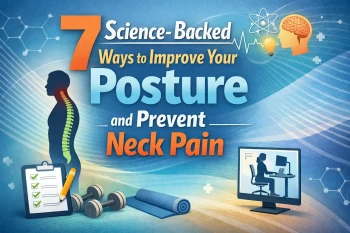
Understanding Cervical Spinal Stenosis
Cervical spinal stenosis occurs when the spinal canal in the neck narrows, placing pressure on the spinal cord and surrounding nerves.
This compression can trigger neck pain, numbness, balance problems, and even fatigue, symptoms that often worsen if left untreated.
The narrowing may develop slowly over time due to arthritis, disc degeneration, or long-standing postural strain. But once the spinal cord is compressed, it can disrupt how the brain communicates with the rest of the body.
Can Cervical Stenosis Cause Fatigue?
Yes, fatigue is a common but overlooked symptom. When the spinal cord or nerves are under pressure, the body must work harder to maintain posture, muscle tone, and coordination.
That ongoing strain can drain your energy.
Patients often notice that after upper cervical correction, when the spine is no longer fighting against misalignment, their energy levels and focus improve naturally.
Other Common Symptoms
- Neck pain and stiffness
- Hand clumsiness or loss of fine motor control
- Difficulty walking or maintaining balance
- Tingling, burning, or “pins and needles” in the arms or legs
- Changes in bladder or bowel control
- In severe cases: loss of function or even paralysis
Is Cervical Spinal Stenosis Progressive?
Without care, it can worsen. Continuous pressure weakens soft tissues, reduces blood flow, and interferes with nerve signals.
When the spinal cord can’t properly communicate with the body, the body’s ability to repair itself diminishes, increasing pain, fatigue, and weakness over time.
Early evaluation is key to preventing permanent nerve damage.
Can Spinal Stenosis Cause Death?
In rare, extreme cases, untreated cervical spinal stenosis can cause paralysis and life-threatening complications. While that outcome is uncommon, the potential seriousness underscores why you shouldn’t ignore persistent neck pain, tingling, or coordination problems.
Prompt, conservative treatment can protect the spinal cord and prevent irreversible injury.
Does Spinal Stenosis Ever Get Better?
It can, especially with the right care.
Traditional options such as medications or surgery focus mainly on symptom management, often with side effects or limited long-term benefit.
Common medical treatments include:
- Pain relievers for short-term comfort
- Anti-seizure drugs to reduce nerve pain
- Antidepressants to ease chronic discomfort
- Opioids (short-term only) for acute pain control
However, these approaches don’t correct the mechanical cause, the misalignment and compression at the cervical spine.
That’s where upper cervical chiropractic offers a natural alternative.
Does Cervical Stenosis Require Surgery?
Surgery is usually a last resort. It may relieve pressure on the spinal cord, but it also carries risks such as infection, nerve damage, and incomplete recovery.
Many Charleston patients explore non-invasive, corrective options first, especially those that target alignment rather than simply removing tissue.
A Natural Approach: Upper Cervical Chiropractic
Upper cervical chiropractic focuses on the top of the spine, the atlas (C1) and axis (C2) vertebrae, which protect the brainstem and coordinate the entire spine’s alignment.
When these vertebrae are even slightly off balance, the rest of the spine compensates, creating compression and tension that can worsen stenosis symptoms.
By gently correcting misalignment at this level, Dr. Youngblood helps:
- Restore brain-to-body communication
- Reduce nerve pressure
- Improve posture and balance
- Encourage the body’s natural healing
Patients often notice relief not just from neck pain but also from related issues like headaches, muscle tightness, or numbness.
What to Expect After an Upper Cervical Adjustment
Realigning the upper neck allows the rest of the spine to “follow suit.”
During this process, it’s common to feel mild soreness as the body resets. Staying hydrated and resting supports the healing phase while your nervous system recalibrates.
As alignment improves, pressure lifts off the spinal cord and nerve roots, and symptoms such as pain, fatigue, and tension often begin to fade.
Can Cervical Spinal Stenosis Be Cured?
Everybody heals differently. Some patients experience dramatic improvement after one adjustment; others see gradual changes as the nervous system repairs communication pathways.
What’s consistent is that upper cervical care treats the root cause, not just the pain.
Many of Dr. Youngblood’s patients have avoided surgery or reduced medication after restoring upper cervical alignment, finding a safer, sustainable path to recovery.
Find Relief in Charleston
If you’re struggling with chronic neck pain, numbness, or balance issues, don’t wait for symptoms to worsen.
Dr. Will Youngblood’s practice at 811 St Andrews Blvd, Ste. A, Charleston, SC 29407 specializes in gentle, precise upper cervical adjustments that restore alignment, reduce nerve pressure, and help your body heal naturally.
📞 Call (843) 225-5855 to schedule a consultation or learn whether upper cervical care may be right for you.
Your spine protects your life; take care of it today.







Leave a comment